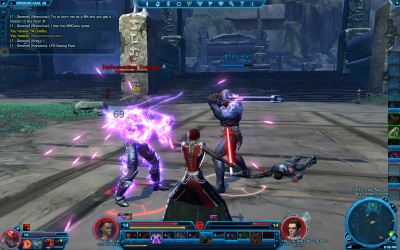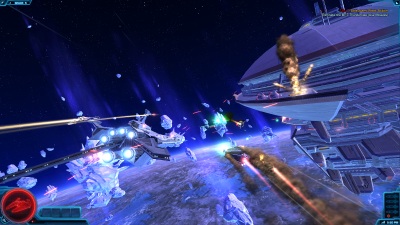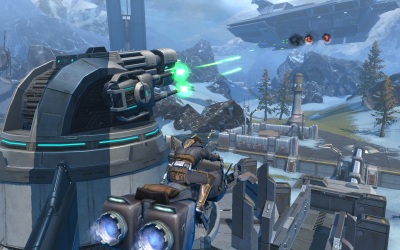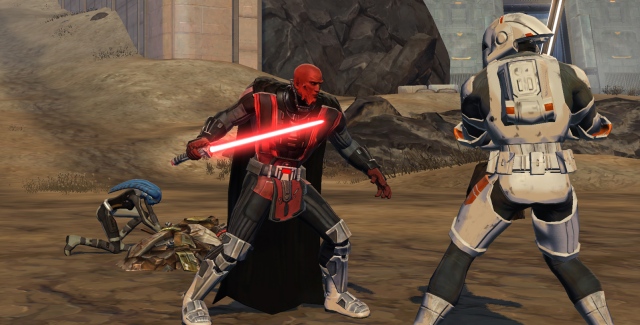Delegating handiworks
I can put the other companions who remain behind on my spaceship to good use by giving them crafting orders. The Old Republic has an assortment of collecting and manufacturing skills for creating useful items. Workshop activities are not the first thing that comes to mind when I think about Star Wars, but it’s an expected feature in MMORPGs. Instead of fiddling around with minuscule details himself, our mighty hero entrusts less glorious tasks, such as transforming goo into medpacs, to his handy subordinates. Crew members can also be sent away for several minutes on retrieval missions to receive additional crafting items upon successful completion.
One annoying aspect of companions is that pretty much every other player has one as well. It felt a little odd when my Inquisitor freed her first companion Khem Val from a Sith vault and learned about his unique background story, only to see other characters roaming around with their very own Khem Val – like a cloning experiment gone wrong. Later in the game it’s less of an issue as a greater companion selection, and different kits to customize the sidekicks’ look, foster diversity.
 Having a computer-controlled buddy who assists in combat makes the game very accessible to players who are used to single-player RPGs. But it also creates unexpected dents in the difficulty curve. The early game feels well-balanced and offers a decent challenge. Upon gaining the first companion around level 8, combat all of a sudden gets a whole lot easier. For example, my heavily armored Bounty Hunter with his devastating gadgets started receiving heals from his first companion Mako. Experienced players looking for a greater challenge in solo play should dismiss companions and only summon them to overcome particularly tough situations.
Having a computer-controlled buddy who assists in combat makes the game very accessible to players who are used to single-player RPGs. But it also creates unexpected dents in the difficulty curve. The early game feels well-balanced and offers a decent challenge. Upon gaining the first companion around level 8, combat all of a sudden gets a whole lot easier. For example, my heavily armored Bounty Hunter with his devastating gadgets started receiving heals from his first companion Mako. Experienced players looking for a greater challenge in solo play should dismiss companions and only summon them to overcome particularly tough situations.
It’s not without minor flaws, but generally I like the companions system a lot. Unlocking additional crew members feels very rewarding. A highlight of every Smuggler career is gaining a personal Wookiee sidekick, while Bounty Hunters recruit the services of an irresistibly cute Jawa. Upgrading companions with better gear and managing their combat abilities are great gameplay additions and learning more about their personalities adds a little extra sparkle to the Star Wars atmosphere.
Occupants of interplanetary craft
After gaining the first companion and picking an advanced class, getting access to a personal spaceship is the next highlight in the career of an Old Republic hero. Players are given the keys to their interplanetary rides as a story quest reward somewhere around character level 15. Traveling to different planets requires entering the ship’s interior at the local spaceport and selecting the destination on a galaxy map. Space travel happens rather quickly on autopilot, no navigational skill required.
The 17 planets that can be visited offer a mix of familiar locales from the movies and new settings. Each world caters to a certain character level range. The iconic deserts of Tatooine are designed for characters in their mid-twenties while the ice landscape of Hoth offers challenges for the level range 37 and up. Other famous locations include Alderaan and Coruscant. The less well-known planets hold their own, offering diverse landscapes ranging from jungles to futuristic cities.
 The Old Republic players don’t control their ship directly – with the notable exception of arcade missions. The galaxy map offers several space battles, which grant character experience points and the occasional ship upgrade upon completion. The space gameplay is radically different from the planet-based questing and reminiscent of 1990s 3D action games such as Star Fox or Star Wars Rebel Assault. Essentially these missions are “rail shooters”, meaning that the ship is flying on autopilot and the player focuses on evading obstacles and targeting hostiles with lasers and missiles.
The Old Republic players don’t control their ship directly – with the notable exception of arcade missions. The galaxy map offers several space battles, which grant character experience points and the occasional ship upgrade upon completion. The space gameplay is radically different from the planet-based questing and reminiscent of 1990s 3D action games such as Star Fox or Star Wars Rebel Assault. Essentially these missions are “rail shooters”, meaning that the ship is flying on autopilot and the player focuses on evading obstacles and targeting hostiles with lasers and missiles.
Those who expect to freely navigate their ship in a 3D space will probably feel disappointed. The ship combat missions are just a simple and entertaining diversion, designed to recreate the excitement of space battles in the Star Wars movies. I enjoy the arcade nature of these interludes, as they are fast-paced and good-looking, with beautiful planet backdrops, enemy fighters whizzing around large frigates and asteroids threatening to dent my ship’s armor. Space missions are a fun distraction that can be completely skipped.
Playing nice with (or against) others
Much has been said about the solo-friendliness of The Old Republic. In many regards the game feels like a hybrid between traditional MMORPGs and Bioware’s 2003 single-player RPG Knights of the Old Republic. But it’s a persistent online world after all with plenty of opportunities to play with or against other players. Users keen on the thrill of “player vs. player” confrontation can even choose a PVP server, where it’s open season once you explore beyond the starting worlds. For more casual players, I strongly recommend regular PVE servers where players of the opposing faction can’t attack at will, as being “ganked” while questing can be an irritating experience.
 Fighting other players on regular servers is limited to three designated warzones that can be entered from character level 10 on. Empire and Republic form teams that try to win by achieving different goals. Three nodes have to be conquered and defended on the Alderaan Civil War map. Voidstar offers Assault-style gameplay with both teams alternating in the roles of attackers and defenders. And in the Huttball scenario, players try to carry a ball into the other team’s end zone. The ball carrier can pass the ball to the nearest player but must be careful not to hand it over to an enemy (my completion rates tend to be in Tim Tebow territory.
Fighting other players on regular servers is limited to three designated warzones that can be entered from character level 10 on. Empire and Republic form teams that try to win by achieving different goals. Three nodes have to be conquered and defended on the Alderaan Civil War map. Voidstar offers Assault-style gameplay with both teams alternating in the roles of attackers and defenders. And in the Huttball scenario, players try to carry a ball into the other team’s end zone. The ball carrier can pass the ball to the nearest player but must be careful not to hand it over to an enemy (my completion rates tend to be in Tim Tebow territory.
Up to four players can form a party for some cooperative fun. Each planet has challenging missions designed specifically for groups and heroic areas that are filled with tougher opponents and better loot. The most exciting group activities are Flashpoints, which offer story-driven quests and tough boss battles in a particular environment. Requiring a balanced group and well-coordinated combat tactics, Flashpoints offer an experience similar to World of Warcraft’s instanced dungeons. High-level characters can also participate in Operations, designed for large raid groups of 8 – 16 players.

